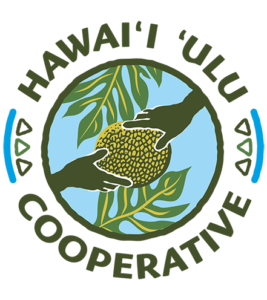Harvesting Blog – How to Determine Mature Fruit
In response to this year’s large harvest volumes, we are clarifying our B-Grade ‘Ulu Specifications through the end of the fiscal year (6/30, 2025) to remove full-size immature (“green”) fruit. Please review the updated Harvesting Guideline on this pagefor the updated standards.
Discerning between mature and full-size immature fruit can be tricky, and we are committed to providing farmers with ongoing education and technical support to successfully meet co-op quality standards and maximize your harvest volumes and revenues.
Discerning between mature and full-size immature breadfruit can varies by variety. Here are some photos showing mature fruit on left and full-size immature fruit on right for the following varieties (from left to right): maoli, otea, lipet, puou




While full-size immature fruit is perfectly edible and may be acceptable for home consumption, it does not meet co-op quality standards for steamed and frozen product due to its more relatively rubbery texture, greenish hue, and stronger “grassy” smell and taste; here are some photos from our processing operation showing full-size immature fruit cut open


Tips for discerning mature vs full-size immature fruit in the field include:
Each variety has its own maturity index; watch our harvesting and variety identification videos to learn more and contact us to find out what variety you have if youʻre unsure. One of the most common breadfruit maturity indicators is the intersegment color, which should change from green to yellow or brown when the fruit is mature; read this guide from UH for more details on how to use this indicator
- Another common maturity indicator identified in the study is % green, with <50% green indicating appropriate maturity in ma’afala variety fruit. Download the app “Canopeo” to your phone to measure the % green on your fruit. *Photos of the fruit need to be cropped so that only the fruit is in the frame, no background, and then uploaded.
- Donʻt use size or latex as an indicator for maturity, as some immature fruit can actually be quite large while sap may drip onto immature fruit from branches or leaves above it
- Immature fruit may smell “grassy” and often has a bright green ring just underneath the skin which can be seen if you cut the fruit open (see photo above)
If youʻre still in doubt, take a photo of your fruit in question and text it to our membership team for feedback!
